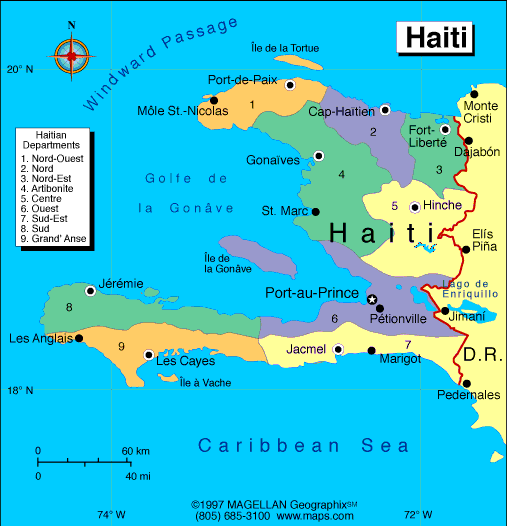HAITI

Geography: Haiti, in the West Indies, occupies the western third of the island of Hispaniola, which it shares with the Dominican Republic. About the size of Maryland, Haiti is two-thirds mountainous, with the rest of the country marked by great valleys, extensive plateaus, and small plains.
Government: Republic with an elected government.
History: Explored by Columbus on Dec. 6, 1492, Haiti's native Arawaks fell victim to Spanish rule. In 1697, Haiti became the French colony of Saint-Dominique, which became a leading sugarcane producer dependent on slaves. In 1791, an insurrection erupted among the slave population of 480,000, resulting in a declaration of independence by Pierre-Dominique Toussaint l'Ouverture in 1801. Napoléon Bonaparte suppressed the independence movement, but it eventually triumphed in 1804 under Jean-Jacques Dessalines, who gave the new nation the Arawak name Haiti . It was the world's first independent black republic.
Government: Republic with an elected government.
History: Explored by Columbus on Dec. 6, 1492, Haiti's native Arawaks fell victim to Spanish rule. In 1697, Haiti became the French colony of Saint-Dominique, which became a leading sugarcane producer dependent on slaves. In 1791, an insurrection erupted among the slave population of 480,000, resulting in a declaration of independence by Pierre-Dominique Toussaint l'Ouverture in 1801. Napoléon Bonaparte suppressed the independence movement, but it eventually triumphed in 1804 under Jean-Jacques Dessalines, who gave the new nation the Arawak name Haiti . It was the world's first independent black republic.

Map of Haiti
President: Michel Martelly
(2011)
Prime Minister:
Evans Paul (2015)
Land area: 10,641 sq mi (27,560 sq km);
total area: 10,714 sq mi (27,750 sq km)
Population (2014 est.): 9,996,731 (growth
rate: 1.08%); birth rate: 22.83/1000; infant mortality rate: 49.43/1000;
life expectancy: 63.18
Capital and largest city (2011 est.):
Port-au-Prince, 2.207 million
Monetary unit:
Gourde
National
name: République d'Haïti
Languages:
Creole and French (both official)
Ethnicity/race:
black 95%, mulatto and white 5%
Religions:
Roman Catholic 80%, Protestant 16% (Baptist 10%,
Pentecostal 4%, Adventist 1%, other 1%), other 3%, none 1%. Note:
roughly half the population practices voodoo
National Holiday:
Independence Day, January 1
Literacy rate: 48.7% (2006 est.)
Economic summary: GDP/PPP (2013 est.):
$13.42 billion; per capita $1,300. Real growth rate: 3.4%.
Inflation: 6.3% (2013). Unemployment: 40.6% (2010 est.). Arable land: 36.04%. Agriculture:
coffee, mangoes, sugarcane, rice, corn, sorghum; wood. Labor
force: 4.81 million; note: shortage of skilled labor, unskilled
labor abundant (2010); agriculture 38.1%, services 50.4%, industry 11.5%.
Industries: sugar refining, flour milling, textiles, cement,
light assembly industries based on imported parts. Natural
resources: bauxite, copper, calcium carbonate, gold, marble,
hydropower. Exports: $876.8 million (2013 est.):
manufactures, coffee, oils, cocoa, mangoes. Imports: $2.697
billion (2013 est.): food, manufactured goods, machinery and
transport equipment, fuels, raw materials. Major trading
partners: U.S., Dominican Republic, Netherlands Antilles, China (2012).
Communications:
Telephones: main lines in use: 50,000 (2012); mobile cellular:
6.095 million (2012). Broadcast media: several
TV stations, including 1 government-owned; cable TV subscription
service available; government-owned radio network; more than 250 private
and community radio stations with about 50 FM stations in
Port-au-Prince alone (2007). Internet hosts: 555 (2012). Internet
users: 1 million (2009).
Transportation:
Railways: n.a. Highways: 4,266 km (2009) Waterways:
n.a. Ports and harbors: Cap-Haitien, Gonaives, Jacmel, Port-au-Prince. Airports: 14
(2013).
International disputes: since
2004, about 8,000 peacekeepers from the UN Stabilization Mission in
Haiti (MINUSTAH) maintain civil order in Haiti; despite efforts to
control illegal migration, Haitians fleeing economic privation and
civil unrest continue to cross into Dominican Republic and to sail to
neighboring countries; Haiti claims US-administered Navassa
Island.
-------------------- o --------------------
No comments:
Post a Comment